AlN/FeNi Microwave-Attenuating Ceramics with High-Efficiency Thermal Conductivity and Microwave Absorption
Abstract
1. Introduction
| Absorbent Type | Main Component | Synthesis Method | λ (W m−1 K−1) | ε’ | RLmin (dB) | EAB (GHz) | Refs. |
|---|---|---|---|---|---|---|---|
| Dielectric loss-type | AlN/SiC | Plasma-activated sintering (1800 °C) | 24.88 | 17 | −16.5 | 2.6 | [14] |
| SG@AlN/SiC | Hot-pressed sintering (1900 °C, 25 MPa) | 63.92 | 11.8 | −34.2 | / | [15] | |
| Conductivity loss-type | AlN/GC | Hot-pressed sintering (1850 °C, 30 MPa) | 70.58 | 20 | −22.21 | 0.5 | [18] |
| AlN/FeSiAl | Pressureless sintering (1800 °C) | 130.18 | 8 | −57.31 | 1.48 | [19] | |
| FeNi@MoS2@CoS2 | MoS2 crystals with FeNi nanoparticles on the surface were grown on CoS2 microspheres | / | 8 | −46.8 | 6.32 | [20] | |
| FeNi | Electroconsolidation | 100 | / | / | / | [21] | |
| FeNi/C | Coprecipitation | / | 12 | −49.90 | 7.23 | [22] |
2. Experimental Procedure
2.1. Sample Preparation
2.2. Sample Characterization
3. Results and Discussion
3.1. Density, Phase Composition, and Microstructure
3.2. Microwave-Absorption Properties
3.3. Thermal Conductivity
4. Conclusions
- (1)
- By tuning the FeNi content, we achieved strong absorption across various frequency bands.
- (2)
- The incorporation of FeNi did not notably compromise the thermal conductivity of the AlN matrix, resulting in the production of AlN/FeNi composites with high thermal conductivity.
- (3)
- The composite doped with 20 wt% FeNi demonstrated the optimal microwave-absorption performance, impedance-matching characteristics, electromagnetic wave-attenuation capacity, and high thermal conductivity.
5. Outlook
- (1)
- Multi-functional materials: Develop thermally conductive AlN-based integrated materials with hydrophobic, vibration-resistant, radiation-resistant, high-temperature-stable, and durable properties to withstand severe environments. Concurrently, focus on the advancement of self-adaptive and self-healing capabilities of the material to extend its lifespan;
- (2)
- Sustainable development: Investigate the sustainability and eco-friendliness of thermal absorbent AlN-based materials, minimizing environmental impact through green chemical synthesis, biosynthesis, and the use of renewable materials;
- (3)
- Expansion of applications: Thermally conductive and absorbing AlN-based materials have seen advancements in numerous fields and are poised to extend into even more fields in the future. Investigating the the interaction mechanisms and coupling effects across different physical domains and leveraging artificial intelligence can achieve efficient material design and performance prediction.
Author Contributions
Funding
Institutional Review Board Statement
Informed Consent Statement
Data Availability Statement
Conflicts of Interest
Nomenclature
| Abbreviations | |
| DSC | Differential scanning calorimeter |
| EDS | Energy dispersive spectroscopy |
| SG | Spherical graphite |
| SEM | Scanning electron microscope |
| XRD | X–ray diffraction |
| Symbols | |
| ω | Angular frequency of the electromagnetic wave |
| α | Absorption coefficient |
| ρv | Bulk density |
| εr | Complex permittivity |
| ur | Complex permeability |
| Z0 | Characteristic impedance of air |
| ρ1 | Density of deionized water |
| m1 | Dry weight |
| σ | Electrical conductivity |
| m3 | Floating weight |
| εʹʹ | Imaginary part of complex permittivity |
| u’’ | Imaginary part of complex permeability |
| f | Incident electromagnetic frequency |
| Z | Impedance |
| Zin | Impedance at the material’s surface |
| RLmin | Minimum reflection loss |
| Zin/Z0 | Normalized input impedance |
| εʹ | Real part of complex permittivity |
| u’ | Real part of the complex permeability |
| ρr | Relative density |
| c | Speed of light |
| m2 | Saturated mass |
| Cp | Specific heat capacity |
| d | Thickness |
| k | Thermal conductivity |
| ki | Thermal conductivity of each component |
| W | Temperature-dependent constant |
| ρt | Theoretical density |
| D | Thermal diffusion coefficient |
| λ | Thermal conductivity |
| ʋi | Volume fraction of each component |
References
- Lv, H.; Cui, J.; Li, B.; Yuan, M.; Liu, J.; Che, R. Insights into civilian electromagnetic absorption materials: Challenges and innovative solutions. Adv. Funct. Mater. 2024, 2315722. [Google Scholar] [CrossRef]
- Katiyar, M.; Prasad, M.; Agarwal, K.; Singh, R.K.; Kumar, A.; Prasad, N.E. Development of low density, heat resistant and broadband microwave absorbing materials (MAMs) for stealth applications. Silicon 2018, 10, 1831–1839. [Google Scholar] [CrossRef]
- Huo, Y.; Zhao, K.; Miao, P.; Kong, J.; Xu, Z.; Wang, K.; Li, F.; Tang, Y. Microwave absorption performance of SiC/ZrC/SiZrOC hybrid nanofibers with enhanced high–temperature oxidation resistance. ACS Sustain. Chem. Eng. 2020, 8, 10490–10501. [Google Scholar] [CrossRef]
- Patel, M.; Reddy, J.J.; Prasad, V.B. High thermal conductivity aluminium nitride–zirconium diboride (AlN–ZrB2) composite as microwave absorbing material. Ceram. Int. 2021, 47, 21882–21889. [Google Scholar] [CrossRef]
- Fu, K.; Yao, Q.; Xu, L.; Zhou, W.; Wang, Z.; Yang, Y.; Tong, G.; Wang, X.; Wu, W. Constructing magnetic/dielectric dual loss and phonon/electron thermal carriers γ–Al2O3–based yolk–shell microspheres to collaboratively advance microwave absorption and heat conduction. Mater. Horiz. 2024, 11, 1065–1078. [Google Scholar] [CrossRef]
- Zhong, X.; He, M.; Zhang, C.; Guo, Y.; Hu, J.; Gu, J. Heterostructured BN@ Co-C@ C endowing polyester composites excellent thermal conductivity and microwave absorption at C band. Adv. Funct. Mater. 2024, 34, 2313544. [Google Scholar] [CrossRef]
- He, Y.; Li, X.; Zhang, J.; Li, X.; Duan, Y.; Huang, M.; Bai, H.; Jiang, D.; Qiu, T. Method for fabricating microwave absorption ceramics with high thermal conductivity. J. Eur. Ceram. Soc. 2018, 38, 501–505. [Google Scholar] [CrossRef]
- Chen, H.; Wang, W.; Yu, X.; Zuo, K.; Xia, Y.; Yin, J.; Liang, H.; Yao, D.; Zeng, Y. The effect of annealing temperature on flexural strength, dielectric loss and thermal conductivity of Si3N4 ceramics. J. Alloys Compd. 2020, 813, 152203. [Google Scholar] [CrossRef]
- Fang, X.; Jiang, L.; Pan, L.; Yin, S.; Qiu, T.; Yang, J. High–thermally conductive AlN–based microwave attenuating composite ceramics with spherical graphite as attenuating agent. J. Adv. Ceram. 2021, 10, 301–319. [Google Scholar] [CrossRef]
- Watari, K.; Hirao, K.; Toriyama, M.; Ishizaki, K. Effect of grain size on the thermal conductivity of Si3N4. J. Am. Ceram. Soc. 1999, 82, 777–779. [Google Scholar] [CrossRef]
- Slack, G.A. Nonmetallic crystals with high thermal conductivity. J. Phys. Chem. Solids 1973, 34, 321–335. [Google Scholar] [CrossRef]
- Krupka, J. Frequency domain complex permittivity measurements at microwave frequencies. Meas. Sci. Technol. 2006, 17, R55. [Google Scholar] [CrossRef]
- Kuang, J.; Xiao, T.; Zheng, Q.; Xiong, S.; Wang, Q.; Jiang, P.; Liu, W.; Cao, W. Dielectric permittivity and microwave absorption properties of transition metal Ni and Mn doped SiC nanowires. Ceram. Int. 2020, 46, 12996–13002. [Google Scholar] [CrossRef]
- Li, P.; Wang, C.; Liu, H.; Shen, Q.; Zhang, L. Structural, thermal and dielectric properties of AlN–SiC composites fabricated by plasma activated sintering. Adv. Appl. Ceram. 2019, 118, 313–320. [Google Scholar] [CrossRef]
- Fang, X.; Hou, S.; Pan, L.; Yin, S.; Wang, Y.; Li, Q.; Chen, D.; Jin, J.; Yang, J. Core–shell spherical graphite@ SiC attenuating agent for AlN–based microwave attenuating ceramics with high–efficiency thermal conduction and microwave absorption abilities. Ceram. Int. 2023, 49, 25063–25073. [Google Scholar] [CrossRef]
- Zhang, Y.; Agrawal, D.K.; Cheng, J.; Slawecki, T. Microwave power absorption mechanism of metallic powders. IEEE Trans. Microw. Theory Tech. 2018, 66, 2107–2115. [Google Scholar] [CrossRef]
- Franz, R.; Wiedemann, G. Ueber die wärme-leitungsfähigkeit der metalle. Ann. Phys. 1853, 165, 497–531. [Google Scholar] [CrossRef]
- Fang, X.; Pan, L.; Yin, S.; Chen, H.; Qiu, T.; Yang, J. Spherical glassy carbon/AlN microwave attenuating composite ceramics with high thermal conductivity and strong attenuation. Ceram. Int. 2020, 46, 21505–21516. [Google Scholar] [CrossRef]
- Wang, L.; An, L.; Zhou, G.; Wang, X.; Sun, K.; Chen, H.; Hou, H. Dense AlN/FeSiAl composite ceramics with high thermal conductivity and strong microwave absorption. J. Mater. Sci. Mater. Electron. 2022, 33, 10723–10733. [Google Scholar] [CrossRef]
- Cao, X.; Jia, Z.; Hu, D.; Wu, G. Synergistic construction of three–dimensional conductive network and double heterointerface polarization via magnetic FeNi for broadband microwave absorption. Adv. Compos. Hybrid Mater. 2022, 5, 1030–1043. [Google Scholar] [CrossRef]
- Khadzhay, G.Y.; Vovk, S.R.; Vovk, R.V.; Gevorkyan, E.S.; Zubenko, N.S.; Kislitsa, M.V.; Chishkala, B.O.; Feher, A.; Kollar, P.; Fuzer, J. Electrical and thermal conductivity of FeNi at low temperatures. Low Temp. Phys. 2020, 46, 939–943. [Google Scholar] [CrossRef]
- Weng, L.; Lei, X.; Zhang, Z.; Wang, J. Porous carbon–loaded hollow FeNi alloy particles for highly efficient electromagnetic wave absorbing materials. Synth. Met. 2023, 295, 117334. [Google Scholar] [CrossRef]
- Zhao, L.; Lo, S.H.; Zhang, Y.; Sun, H.; Tan, G.; Uher, C.; Wolverton, C.; Dravid, V.P.; Kanatzidis, M.G. Ultralow thermal conductivity and high thermoelectric figure of merit in SnSe crystals. Nature 2014, 508, 373–377. [Google Scholar] [CrossRef]
- Zhang, B.; Wu, C.; Ye, K.; Sun, C.; Wang, Z. Dual–induced SiC/SME multifunction composite for high–efficiency broadband electromagnetic wave absorption. Carbon 2023, 213, 118253. [Google Scholar] [CrossRef]
- Lichtenecker, K. Die ableitung der logarithmischen mischungsregel aus dem maxwell–rayleighschen schrankenwertverfahren. Kolloidchem. Beih. 1926, 23, 285–291. [Google Scholar] [CrossRef]
- Wu, H.; Qin, M.; Zhang, L. NiCo2O4 constructed by different dimensions of building blocks with superior electromagnetic wave absorption performance. Compos. Part B 2020, 182, 107620. [Google Scholar] [CrossRef]
- Kingery, W.D. Thermal conductivity: XIV, conductivity of multicomponent systems. J. Am. Ceram. Soc. 1959, 42, 617–627. [Google Scholar] [CrossRef]
- Chasnyk, V.I.; Chasnyk, D.V.; Fesenko, I.P.; Kaidash, O.M.A. Study of the thermal conductivity, electrical resistivity, and microwave absorption of pressureless sintered AlN–Y2O3–Mo and AlN–Y2O3–TiN composites. J. Superhard Mater. 2020, 42, 165–176. [Google Scholar] [CrossRef]
- Chasnyk, V.; Chasnyk, D.; Fesenko, I.; Kaidash, O.; Turkevych, V. Dielectric characteristics of pressureless sintered AlN–based composites in the 3–37 GHz frequency range. J. Mater. Sci. Mater. Electron. 2021, 32, 2524–2534. [Google Scholar] [CrossRef]
- Zhao, J.; Chen, H.; Yang, J.; Li, J.; Wang, Z.; Zhou, G.; Ma, Z.; Gu, Q. Microwave absorption, thermal and mechanical properties of amorphous nano carbon doped aluminium nitride composite ceramics. Ceram. Int. 2024, 50, 30931–30939. [Google Scholar] [CrossRef]
- Fang, X.; Jiang, S.; Pan, L.; Yin, S.; Qiu, T.; Yang, J.; Li, X. β-SiC/AlN microwave attenuating composite ceramics with excellent and tunable microwave absorption properties. J. Eur. Ceram. Soc. 2021, 41, 6385–6392. [Google Scholar] [CrossRef]
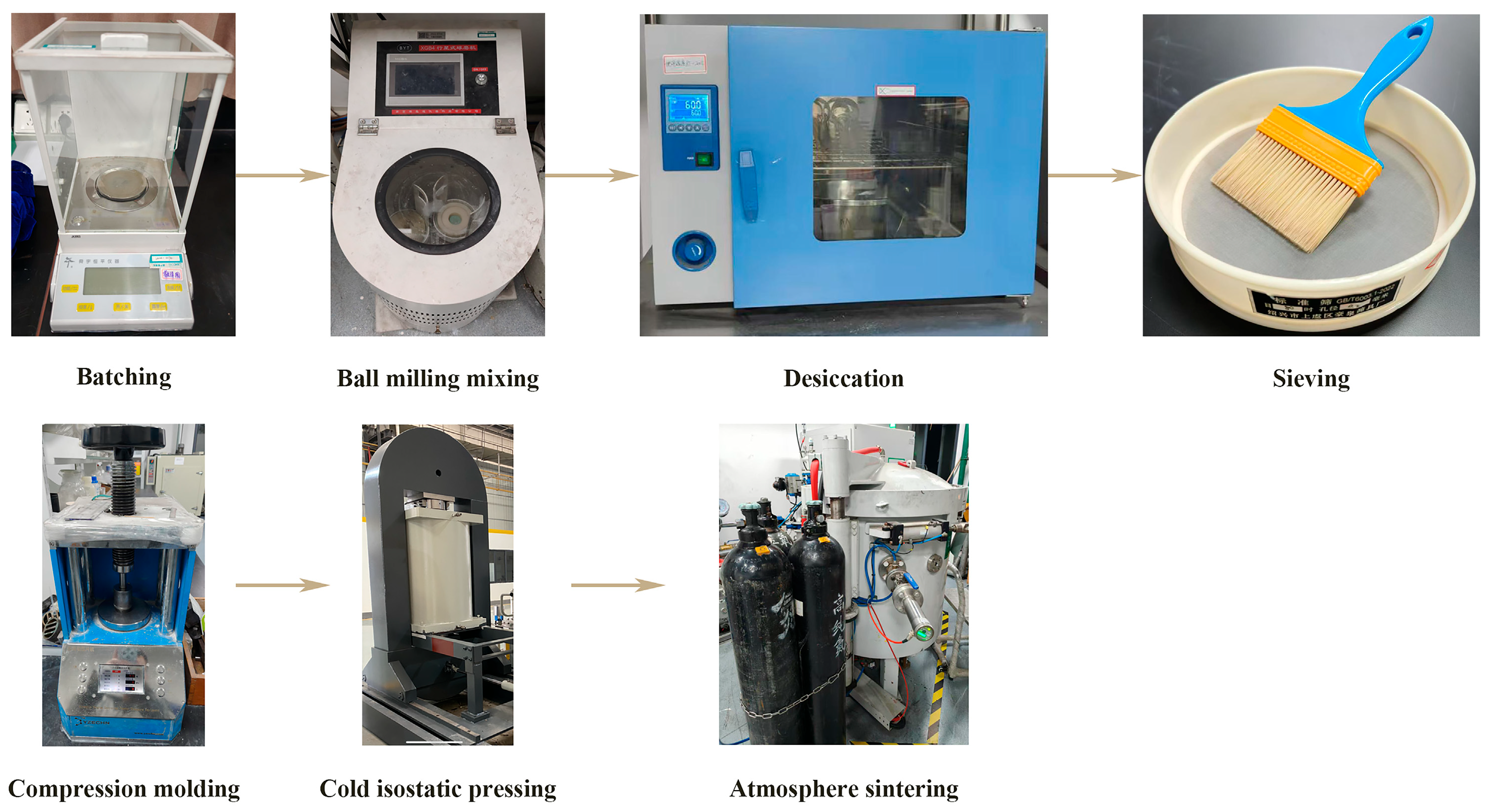
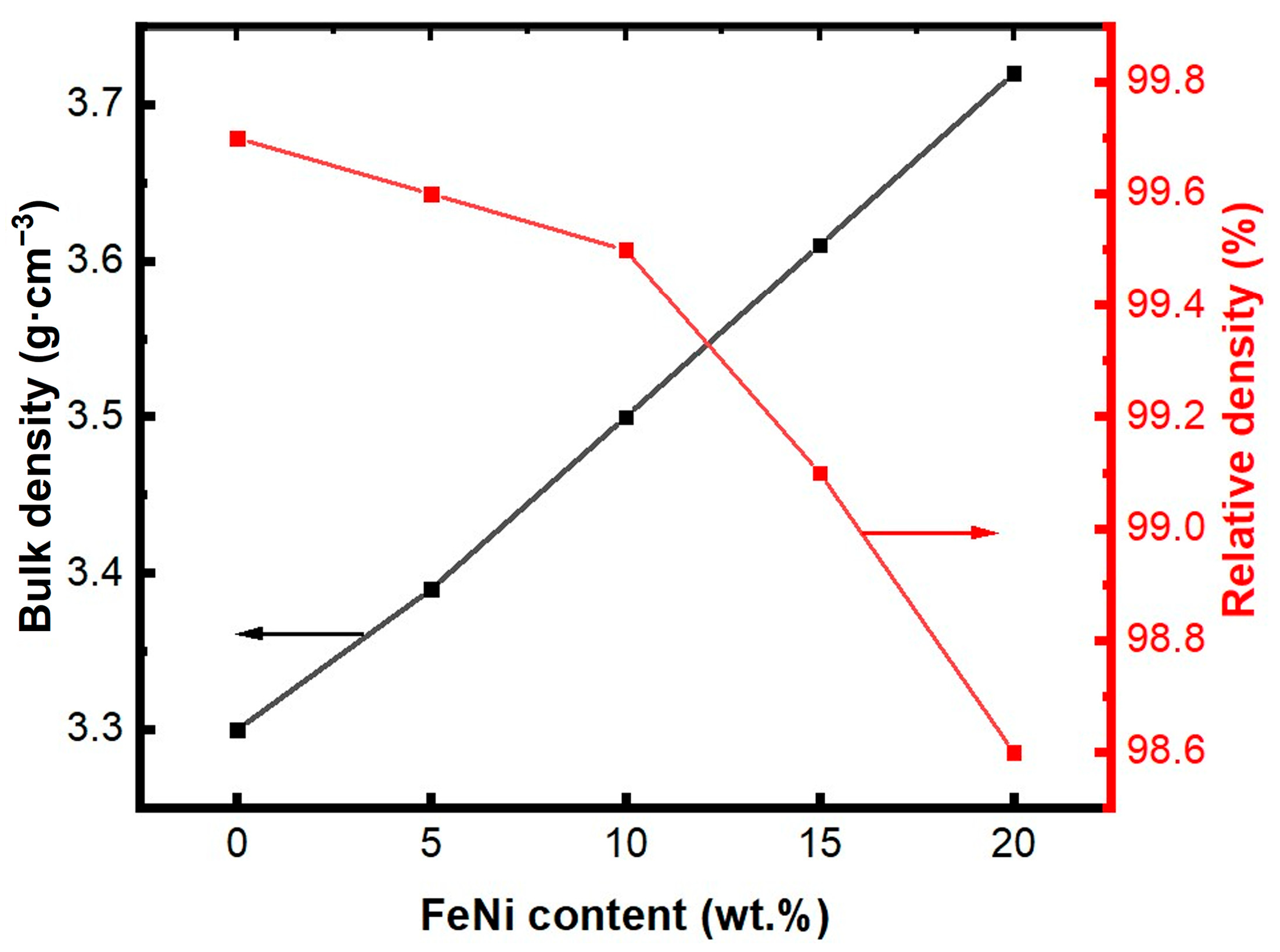
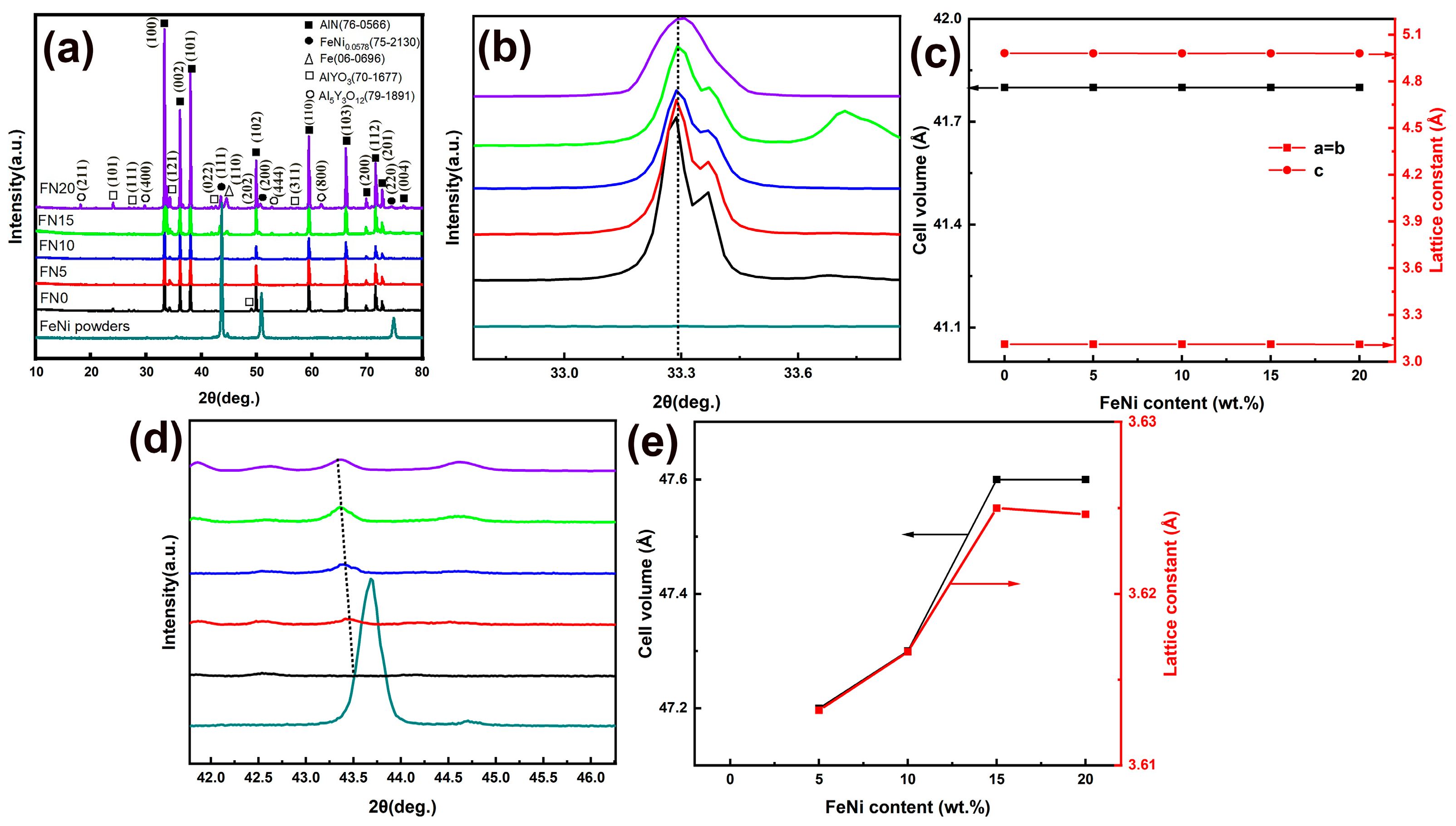

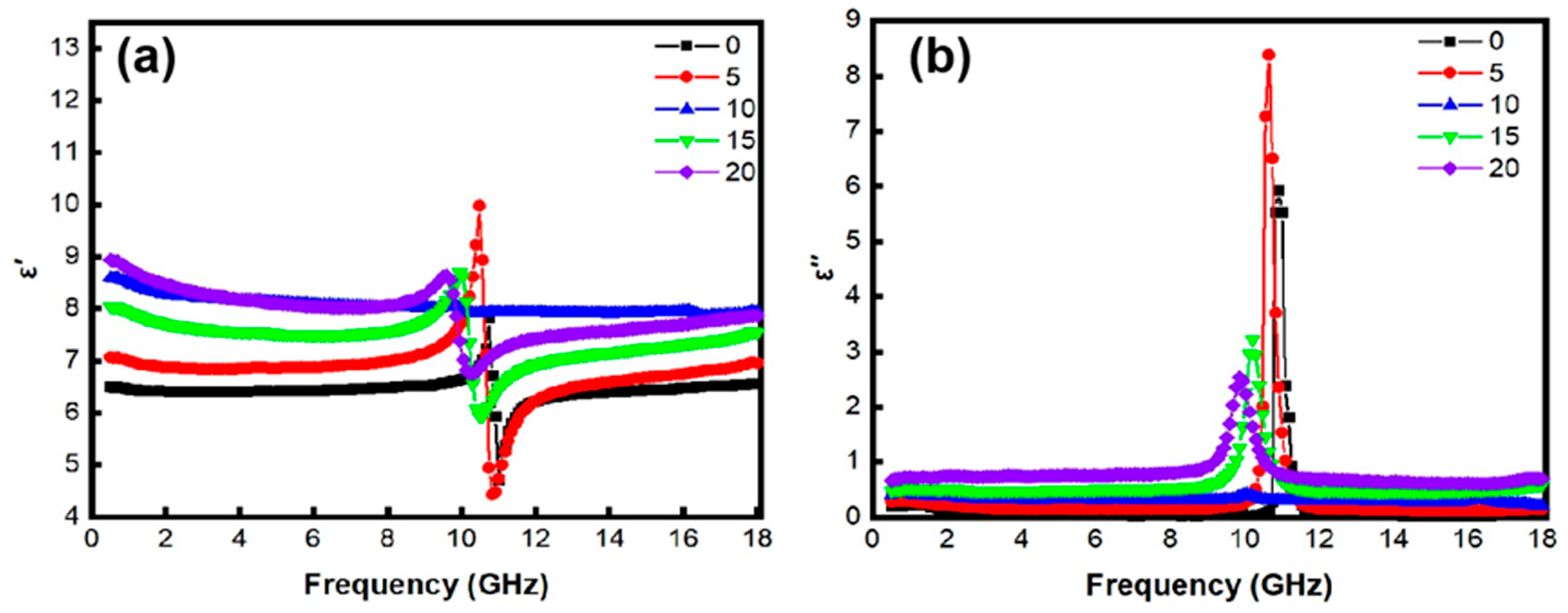
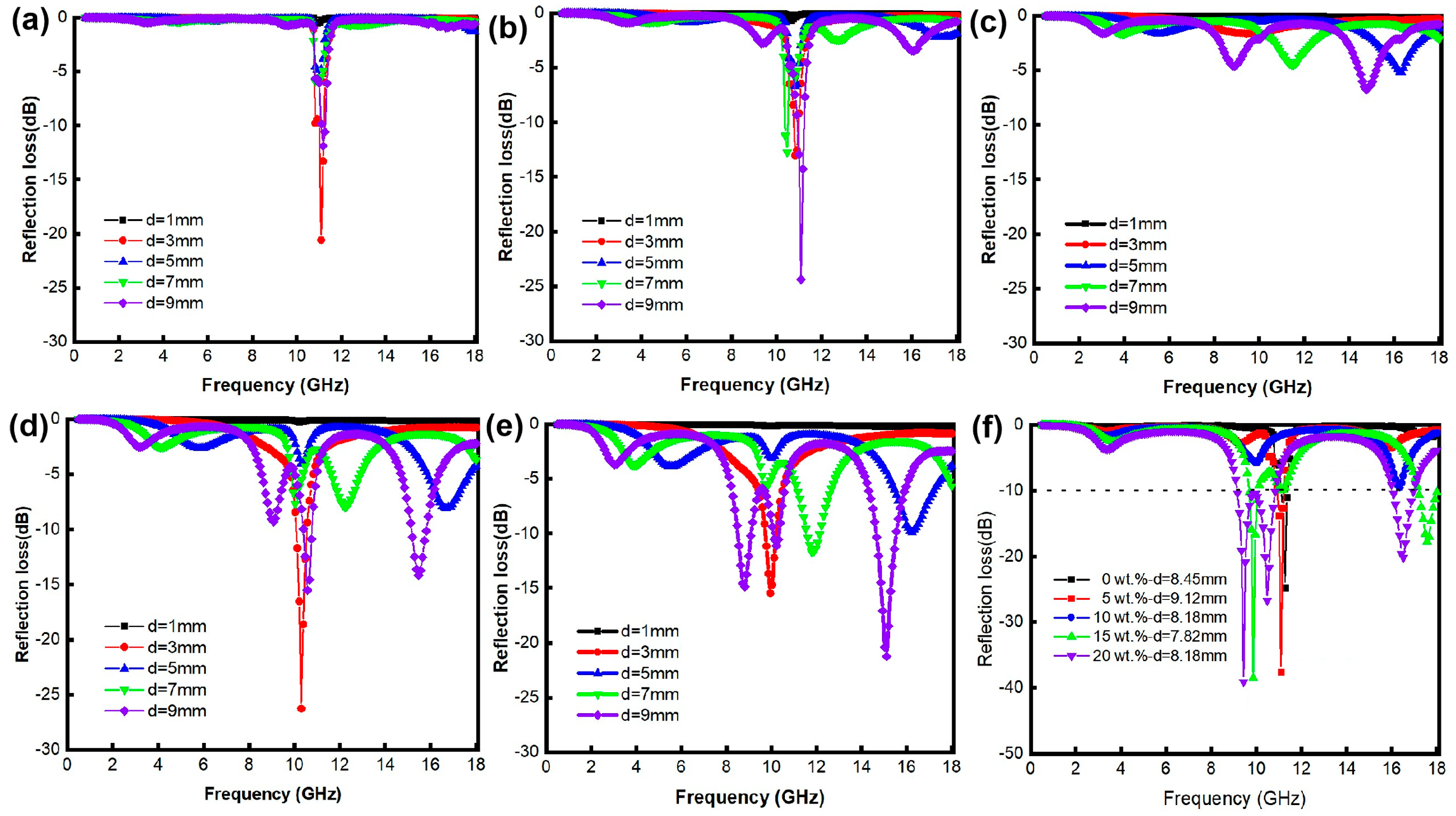
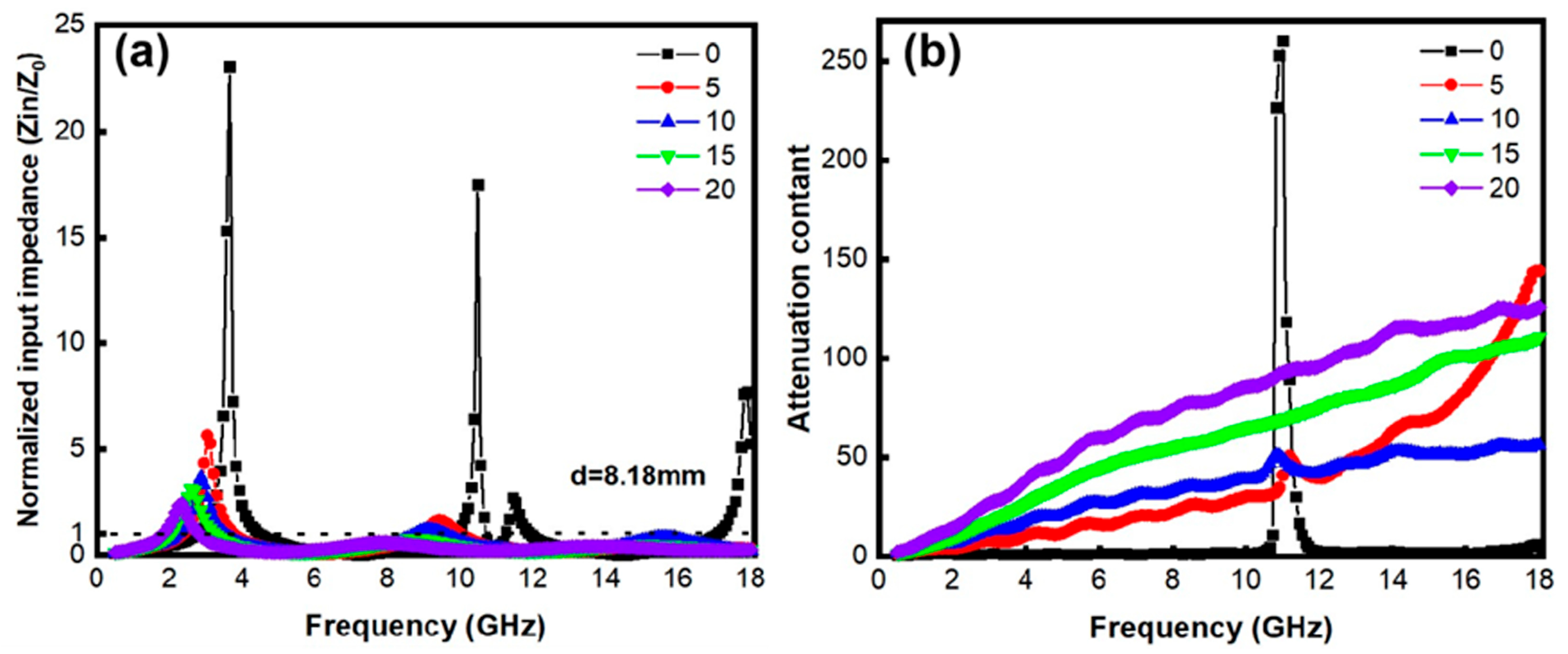
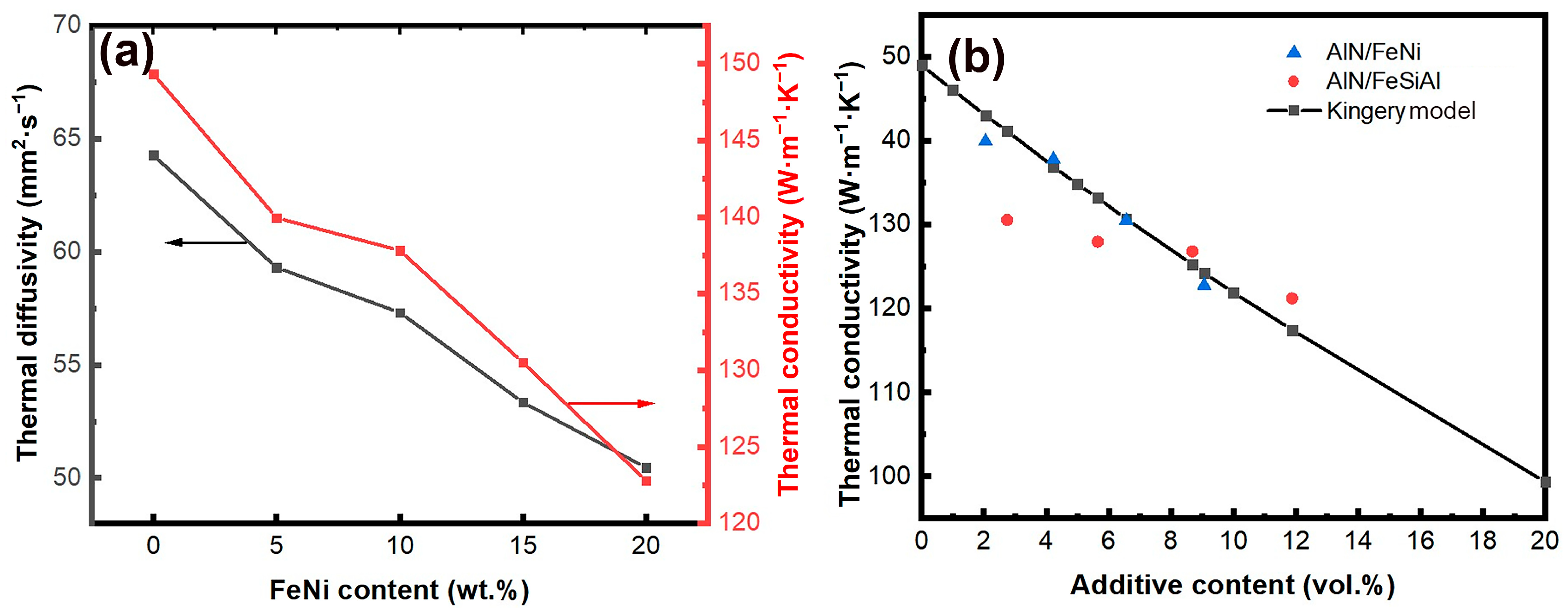
| Absorbent Type | Main Component | Synthesis Method | λ (W m−1 K−1) | ε’ | RLmin (dB) | EAB (GHz) | Refs. |
|---|---|---|---|---|---|---|---|
| Conductivity loss-type | AlN/Mo | Hot-pressed sintering (0.12 MPa, 1850 °C) | 76 | 24 | −32 | / | [28] |
| AlN/W | Pressureless sintering (1850 °C) | 68 | 15 | −23 | / | [29] | |
| AlN/ZrB2 | Hot-pressed sintering (20 MPa, 1850 °C) | 82 | 10 | / | / | [4] | |
| AlN/TiB2 | Pressureless sintering (1850 °C) | 77 | 10.5 | −5 | / | [29] | |
| AlN/C | Hot-pressed sintering (1800 °C) | 50.1 | 13.9 | −49.4 | 2 | [30] | |
| AlN/FeSiAl | Pressureless sintering (1800 °C) | 130.2 | 8.3 | −57.3 | 1.5 | [19] | |
| Dielectric loss-type | AlN/SiC | Hot-pressed sintering (1900 °C, 25 MPa) | / | 60 | −24.2 | / | [31] |
Disclaimer/Publisher’s Note: The statements, opinions and data contained in all publications are solely those of the individual author(s) and contributor(s) and not of MDPI and/or the editor(s). MDPI and/or the editor(s) disclaim responsibility for any injury to people or property resulting from any ideas, methods, instructions or products referred to in the content. |
© 2025 by the authors. Licensee MDPI, Basel, Switzerland. This article is an open access article distributed under the terms and conditions of the Creative Commons Attribution (CC BY) license (https://creativecommons.org/licenses/by/4.0/).
Share and Cite
Lin, Y.; Chen, H.; Wang, L.; An, L.; Qin, X.; Zhou, G. AlN/FeNi Microwave-Attenuating Ceramics with High-Efficiency Thermal Conductivity and Microwave Absorption. Materials 2025, 18, 367. https://doi.org/10.3390/ma18020367
Lin Y, Chen H, Wang L, An L, Qin X, Zhou G. AlN/FeNi Microwave-Attenuating Ceramics with High-Efficiency Thermal Conductivity and Microwave Absorption. Materials. 2025; 18(2):367. https://doi.org/10.3390/ma18020367
Chicago/Turabian StyleLin, Yuanwei, Hetuo Chen, Longfei Wang, Liqiong An, Xianpeng Qin, and Guohong Zhou. 2025. "AlN/FeNi Microwave-Attenuating Ceramics with High-Efficiency Thermal Conductivity and Microwave Absorption" Materials 18, no. 2: 367. https://doi.org/10.3390/ma18020367
APA StyleLin, Y., Chen, H., Wang, L., An, L., Qin, X., & Zhou, G. (2025). AlN/FeNi Microwave-Attenuating Ceramics with High-Efficiency Thermal Conductivity and Microwave Absorption. Materials, 18(2), 367. https://doi.org/10.3390/ma18020367








